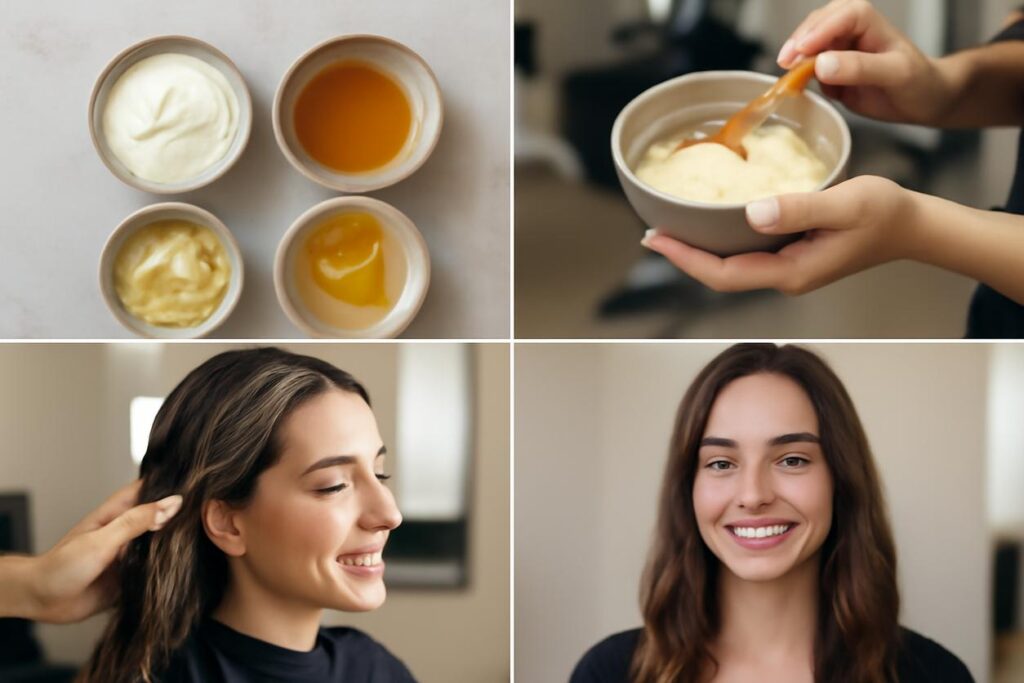Table of Contents
- Why Overnight Care Transforms Hair Health
- How to Evaluate Your Hair Before Bedtime
- Preparing the Hair for Sleep
- Protective Styling and Sleep-Safe Techniques
- DIY Overnight Treatments and Masks
- Morning Wakeup Routine to Preserve Overnight Gains
- Troubleshooting Common Overnight Problems
- Tips for Specific Needs: Color Treated, Curly, Fine and Thinning Hair
- Creating a 7-Night Plan and Tracking Progress
- Scientific Notes and When to Consult a Professional
Why Overnight Care Transforms Hair Health
Imagine waking up with healthier, more manageable hair without adding a single minute to your hectic morning schedule. This isn’t a fantasy; it’s the power of a consistent overnight hair care routine. While you sleep, your body is in a state of repair and regeneration. This provides a unique, uninterrupted window of 6 to 8 hours for your hair to absorb treatments, recover from daily stressors, and be protected from physical damage.
Unlike quick daytime conditioners, overnight treatments have ample time to penetrate the hair shaft, delivering deep hydration and nutrients. Furthermore, proper overnight hair care focuses on minimizing friction from tossing and turning, which is a primary cause of frizz, split ends, and breakage. By adopting a few simple nightly habits, you can protect your strands, lock in moisture, and make your mornings significantly easier. It’s a strategic investment in your hair’s long-term health that works while you rest.
How to Evaluate Your Hair Before Bedtime
The most effective overnight hair care is not one-size-fits-all. A routine that works wonders for your friend might leave your hair greasy or dry. The secret to success lies in personalizing your approach based on your hair’s unique characteristics, specifically its porosity and texture. Taking a few minutes to assess your hair will empower you to choose the right products and techniques for maximum benefit.
Quick Porosity Check You Can Do at Home
Hair porosity refers to your hair’s ability to absorb and retain moisture. It’s determined by the structure of your hair’s cuticle layer. You can easily test this at home.
- The Float Test: Take a single, clean strand of hair (from your brush is fine) and drop it into a glass of water.
- Low Porosity: If the strand floats at the top, you have low porosity hair. The cuticles are tightly packed, making it difficult for moisture to get in. This hair type is prone to product buildup.
- Normal Porosity: If the strand floats in the middle of the glass for a while before sinking, your hair has normal porosity. It absorbs and retains moisture well.
- High Porosity: If the strand sinks quickly to the bottom, you have high porosity hair. The cuticles are raised or have gaps, so it absorbs moisture easily but also loses it just as fast. This hair is often prone to frizz and dryness.
Identifying Your Hair Texture and Common Needs
Hair texture describes the thickness or diameter of an individual hair strand. Roll a single strand between your fingers to identify yours.
- Fine Hair: You can barely feel the strand. It’s delicate and can be easily weighed down by heavy products. The main goal is to protect it from breakage without sacrificing volume.
- Medium Hair: You can feel the strand, but it isn’t stiff or wiry. This is the most common texture and is generally resilient, but still requires balanced care.
- Coarse Hair: The strand feels thick and strong. It is often more resilient but can be prone to dryness and may require more moisture to stay soft and manageable.
Understanding this combination—for example, low porosity, fine hair or high porosity, coarse hair—is the foundation for building your perfect overnight hair care plan.
Preparing the Hair for Sleep
Once you understand your hair’s needs, you can prep it for a night of restoration. This stage is about creating the ideal canvas for your treatments and protective styles, ensuring you get the most out of your sleep.
Best Cleansing and Conditioning Timing
Going to bed with soaking wet hair is a recipe for damage. Hair is at its most fragile when wet, making it susceptible to stretching and breaking against your pillow. Furthermore, a damp scalp can create a breeding ground for fungus. The best practice is to wash your hair a few hours before bed, allowing it to at least 70-80% air-dry. This ensures your hair is receptive to products without being in a vulnerable state.
Lightweight Leave-in Options and How to Choose
A leave-in conditioner or serum is a crucial step in your overnight hair care. It seals in moisture and provides a slip that helps reduce friction. The key is choosing the right one for your hair type:
- For Low Porosity and Fine Hair: Opt for water-based, lightweight mists or sprays. These provide hydration without the heavy oils and butters that can cause buildup and weigh hair down.
- For Normal Porosity and Medium Hair: You have flexibility. A light lotion or cream-based leave-in can provide the perfect balance of moisture and nourishment.
- For High Porosity and Coarse Hair: Your hair craves moisture. Look for richer creams or oils that will seal the cuticle and prevent moisture from escaping overnight.
Apply a small amount, focusing on the mid-lengths and ends where hair is the oldest and driest.
Protective Styling and Sleep-Safe Techniques
The main enemy of healthy hair at night is friction. Tossing and turning can rough up the hair cuticle, leading to tangles, frizz, and breakage. Protective styling is the simple, effective solution.
Braid, Twist and Pineapple Methods Explained
The goal of a protective style is to contain your hair loosely, preventing it from rubbing against your pillowcase. Never tie your hair too tightly, as this can cause tension and lead to breakage (traction alopecia).
- Loose Braid: A classic for a reason. A single loose braid or two pigtail braids works well for straight or wavy hair. It prevents tangles and can create gentle waves by morning.
- Twists: Two-strand twists are ideal for curly and coily hair types. They help clump curls together, reducing frizz and maintaining definition without stretching out the pattern too much.
- The Pineapple: This is a favorite in the curly hair community. Gather your hair into a very high, loose ponytail on top of your head, secured with a gentle tie like a scrunchie. This protects your curl pattern and prevents it from getting crushed while you sleep.
Pillowcase Fabrics and Head Coverings Compared
The surface your hair rests on matters immensely. A simple switch can dramatically improve your overnight hair care results.
- Cotton Pillowcases: These are absorbent and have a rough texture. They can sap moisture from your hair and cause significant friction, leading to frizz and breakage.
- Silk or Satin Pillowcases: These materials are a game-changer. Their smooth surface allows hair to glide across it, reducing friction and helping to retain moisture. This is a simple swap with a huge payoff.
- Bonnets, Scarves, and Turbans: For ultimate protection, especially for curly, coily, or high porosity hair, a silk or satin head covering is ideal. It fully encases the hair, minimizing all friction and helping to hold styles and treatments in place.
DIY Overnight Treatments and Masks
You don’t need expensive products to give your hair a nourishing boost. Your kitchen pantry holds powerful ingredients for effective, natural overnight hair care treatments. For any DIY mask, it’s wise to sleep with a towel over your pillow to protect your bedding.
Nourishing Oil Blends for Different Hair Types
A light application of oil before bed can seal ends and add shine. Use just a few drops, warmed in your palms and smoothed over the ends.
- Fine or Low Porosity Hair: Use very lightweight oils like grapeseed oil or argan oil that absorb quickly.
- Medium Hair: Jojoba oil is a great choice as its structure is very similar to our scalp’s natural sebum.
- Coarse or High Porosity Hair: Richer oils like coconut oil or olive oil can provide intense moisture and help seal the cuticle.
Simple Overnight Mask Recipes with Pantry Ingredients
Apply these masks to damp hair, cover with a shower cap and a bonnet, and rinse out in the morning. Use them once a week or as needed.
- Hydrating Aloe and Honey Mask: Mix 2 tablespoons of pure aloe vera gel with 1 tablespoon of honey. Aloe vera is hydrating and packed with vitamins, while honey is a natural humectant that draws moisture into the hair.
- Strengthening Coconut Oil and Egg Yolk Mask: Whisk one egg yolk with 2 tablespoons of melted coconut oil. The protein in the egg yolk helps strengthen the hair shaft, while coconut oil provides deep conditioning. (Note: Rinse with cool water to avoid cooking the egg!).
Morning Wakeup Routine to Preserve Overnight Gains
Your morning routine is just as important as your nightly prep. The goal is to gently transition your hair from its protected state to its daytime style with minimal stress.
Gentle Detangling and Refresh Options
After carefully taking down your protective style, resist the urge to immediately grab a brush. Start by finger detangling to gently separate any large sections. If you need more, use a wide-tooth comb, starting from the ends and working your way up to the roots. For wavy and curly hair, you can refresh your pattern by spritzing it with a mix of water and a small amount of leave-in conditioner, then gently scrunching.
Troubleshooting Common Overnight Problems
Even with a great routine, you might encounter a few issues. Here’s how to address the most common overnight hair care challenges.
Reducing Frizz, Minimizing Breakage, and Preventing Flat Roots
- To Reduce Frizz: This is almost always caused by friction or a lack of moisture. The number one solution is a silk or satin pillowcase or bonnet. Ensure your hair is fully dry before bed and that you’re using a suitable leave-in conditioner.
- To Minimize Breakage: If you’re seeing short, broken hairs, your protective style may be too tight. Ensure your braids, twists, and ponytails are loose and not pulling on the scalp. Also, avoid harsh elastic ties; opt for soft scrunchies or spiral hair ties.
- To Prevent Flat Roots: Fine or straight hair can sometimes look flat after being in a braid. Try the pineapple method even for straight hair to keep roots lifted. You can also loosely clip up the root sections on top of your head with small claw clips before putting on your bonnet.
Tips for Specific Needs: Color Treated, Curly, Fine and Thinning Hair
Tailor your overnight hair care to address your specific hair concerns.
- Color-Treated Hair: Focus on moisture and color preservation. Use leave-in products with UV protectants and masks that are formulated to be color-safe. Silk pillowcases are especially beneficial to prevent cuticle roughening that can cause color to fade.
- Curly Hair: The main goals are moisture and definition. The pineapple method combined with a satin bonnet is essential. Refreshing with a water-based spray in the morning is key to reviving your curl pattern.
- Fine and Thinning Hair: Avoid heavy oils and creams that will weigh hair down. Focus on protecting delicate ends with a very light serum. A loose braid and a silk pillowcase can prevent tangles without sacrificing volume. Consider a gentle scalp massage with your fingertips before bed to stimulate blood flow.
Creating a 7-Night Plan and Tracking Progress
Consistency is everything. A structured plan for your overnight hair care ensures you are giving your hair a balanced diet of moisture, protein, and rest. Here’s a sample plan you can adapt for 2025 and beyond.
| Night | Overnight Hair Care Action |
|---|---|
| Monday (Wash Day) | Wash hair in the evening. Apply a lightweight leave-in conditioner. Style in a loose braid. |
| Tuesday | Hair is down. Apply a drop of argan or grapeseed oil to ends. Sleep in a pineapple style. |
| Wednesday | Hair is down. Protect with a silk scarf or bonnet. No additional product. |
| Thursday | Apply a DIY overnight mask (e.g., aloe and honey). Cover with a cap and bonnet. |
| Friday (Wash Day) | Rinse mask and wash hair. Apply leave-in. Style in loose twists. |
| Saturday | Hair is down. Protect with a silk pillowcase. No additional product. |
| Sunday | Gentle scalp massage. Protect hair in a loose braid. |
Keep a small journal or note on your phone to track how your hair feels each morning. This will help you learn what it loves and adjust your routine accordingly.
Scientific Notes and When to Consult a Professional
Your hair’s health is a reflection of your internal health. The hair growth cycle and nutritional status play a significant role in its appearance and strength. For more information on hair health resources, you can explore platforms like Rich Hair UK. While an overnight hair care routine can dramatically improve the condition of the hair you have, it’s also important to support it from within through a balanced diet, as research consistently shows a link between nutrition and hair follicle health. For an in-depth look, a great resource is the hair nutrition research available on PubMed.
If you experience persistent problems like excessive hair loss, severe dandruff, or a painful, itchy scalp, these may be signs of an underlying medical condition. In such cases, it is best to consult a dermatologist or a certified trichologist who can provide a professional diagnosis and a targeted treatment plan.






